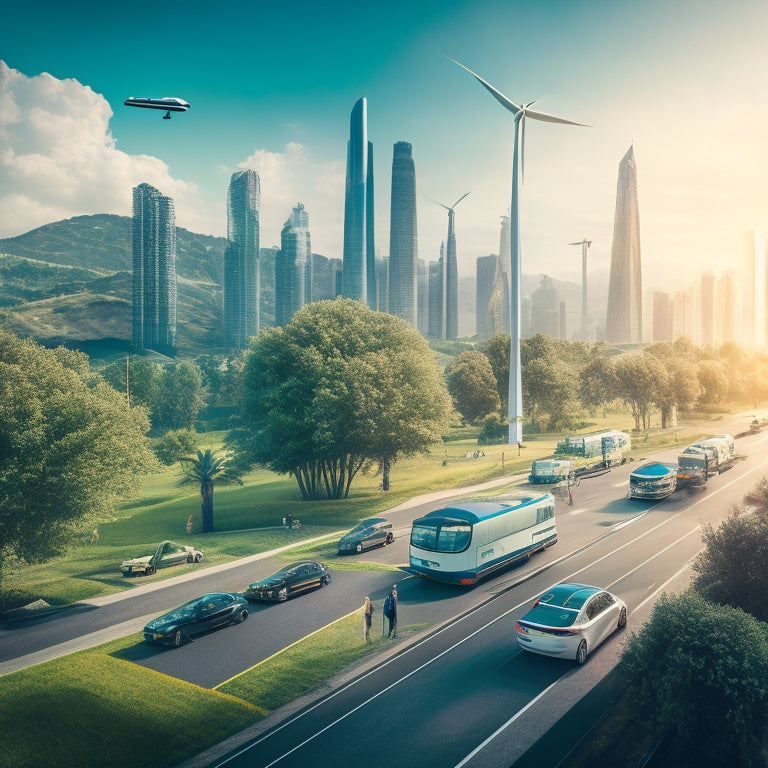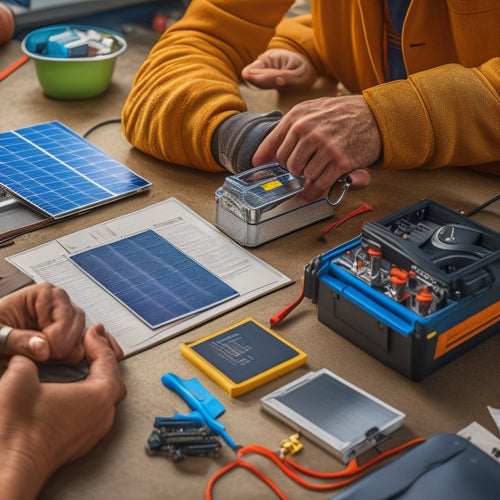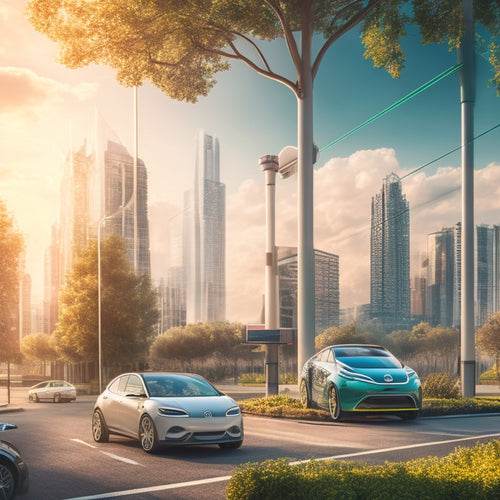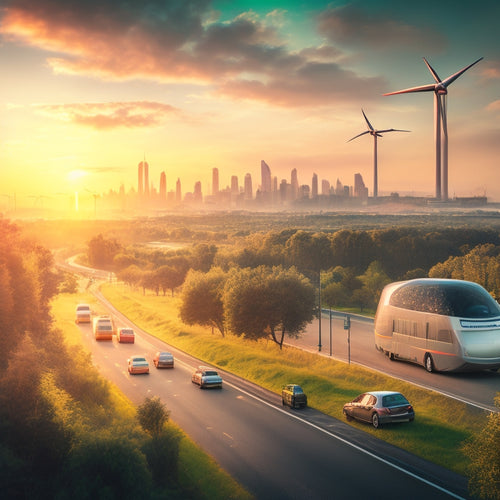
5 Ways to Green Urban Transportation With EVS
Share
You can greatly reduce your carbon footprint and contribute to a cleaner environment by replacing traditional fossil fuel-based transportation with electric vehicles (EVs) in urban areas. Electrify public transit systems, shifting to electric buses that reduce emissions and operating costs. Develop robust EV charging infrastructure, prioritizing scalability and sustainability. Convert last-mile delivery fleets to EVs, optimizing routes and educating drivers. Implement targeted incentives to accelerate EV adoption, addressing upfront costs and range anxiety. Optimize urban EV parking systems, strategically locating charging stations and allocating spaces efficiently. As you explore these strategies, you'll uncover even more opportunities to green your urban transportation network.
Key Takeaways
• Electrify public transit systems by integrating electric buses into Bus Rapid Transit systems to reduce emissions and operating costs.
• Develop robust EV charging infrastructure with strategic planning, effective grid management, and smart charging systems to support widespread adoption.
• Convert last-mile delivery fleets to electric vehicles, optimizing fleet management, routes, and driver education to decrease carbon footprint and air pollution.
• Implement targeted incentives, such as subsidies and tax credits, to accelerate EV adoption and alleviate range anxiety.
• Optimize urban EV parking systems by strategically locating charging stations, prioritizing parking spots, and providing real-time information to reduce range anxiety.
Electrifying Public Transit Systems
As you explore ways to green urban transportation, electrifying public transit systems is an essential step, considering that buses and trains account for nearly 20% of the total greenhouse gas emissions from transportation. You'll find that shifting to electric buses can greatly reduce emissions and operating costs.
Implementing Bus Rapid Transit (BRT) systems, which combine the efficiency of rail transit with the flexibility of buses, can further enhance the benefits. By integrating electric buses into BRT systems, you can create efficient and sustainable transportation networks.
To maximize the impact, focus on developing Transit Hubs that connect different modes of transportation, such as buses, trains, and bike-share systems. These hubs can become central nodes for electric vehicle (EV) adoption, providing convenient charging infrastructure and encouraging the widespread adoption of EVs.
EV Charging Infrastructure Development
Developing a robust EV charging infrastructure is important to support the widespread adoption of electric vehicles in urban transportation, and you'll need to strategically plan and deploy a network of charging stations that can meet the growing demand for EVs.
As you start on this project, it's important to take into account the strain that increased EV adoption will put on the grid. Effective Grid Management is critical to prevent brownouts and guarantee a stable power supply. One approach is to implement Smart Charging systems, which can optimize charging times based on energy demand and availability. This technology can also help reduce peak-hour demand and alleviate pressure on the grid.
By integrating Smart Charging into your infrastructure development plan, you'll be able to efficiently manage energy distribution and provide a seamless charging experience for EV owners.
As you design your EV charging infrastructure, prioritize scalability, reliability, and sustainability to create a robust network that supports the growth of electric vehicles in urban transportation.
Greening Last-Mile Delivery Fleets
You can greatly decrease your carbon footprint by converting your last-mile delivery fleets to electric vehicles, which can result in a substantial decrease in greenhouse gas emissions and air pollution in urban areas. This shift requires a strategic approach to optimize the entire delivery process. Effective fleet management involves selecting the right electric vehicles, optimizing routes, and consolidating loads to reduce the number of vehicles on the road.
| Strategy | Benefits |
|---|---|
| Fleet Management | Optimize vehicle allocation and reduce idle time |
| Route Optimization | Reduce miles driven and lower emissions |
| Vehicle Selection | Choose EVs with suitable range and payload capacity |
| Load Consolidation | Decrease the number of vehicles on the road |
| Driver Training | Educate drivers on EV-specific operations and efficiency |
Promoting EV Adoption Incentives
To accelerate the shift to electric vehicles, governments and organizations must implement targeted incentives that address the upfront costs and range anxiety associated with EV adoption.
You, as a potential EV owner, are likely deterred by the high purchase price and concerns about running out of charge. To alleviate these concerns, governments can offer vehicle subsidies to reduce the upfront cost. For instance, you could receive a rebate or tax credit for purchasing an EV.
Additionally, incentives for home charging infrastructure can help alleviate range anxiety. Governments can offer subsidies for installing home charging stations, making it more convenient and affordable for you to charge your vehicle.
Optimizing Urban EV Parking Systems
By strategically locating EV charging stations near high-demand parking areas, cities can optimize urban EV parking systems, streamlining the charging process and encouraging wider adoption of electric vehicles.
You'll want to prioritize parking spots with access to charging infrastructure, making it convenient for EV owners to recharge on-the-go.
Implementing smart parking systems can help allocate parking spaces efficiently, reducing congestion and emissions. This can be achieved through priority allocation, where EVs are given preferential parking spots with charging access.
Additionally, smart parking systems can provide real-time information on available charging spots, reducing range anxiety and encouraging more drivers to switch to EVs.
Frequently Asked Questions
Can Electric Vehicles Be Charged Using Renewable Energy Sources?
You can charge your electric vehicle using renewable energy sources like solar power and wind energy, which can be stored in energy storage systems, creating a green grid that supports carbon neutrality.
How Do EVS Reduce Greenhouse Gas Emissions in Urban Areas?
You'll be amazed to know that EVs can reduce greenhouse gas emissions by up to 70%! By switching to EVs, you'll shrink your carbon footprint, combat urban sprawl, and boost fuel efficiency, ultimately improving air quality and reducing traffic congestion.
Are Electric Motorcycles a Viable Alternative to Cars?
As you consider electric motorcycles, you'll find they're a viable alternative to cars, offering improved Rider Safety through advanced Bike Design, with features like regenerative braking and optimized ergonomics, making them a smart, eco-friendly choice for you.
Can Urban Planning Design Reduce EV Charging Infrastructure Needs?
As you navigate the complexities of urban planning, you'll find that designing cities with smart grids, mixed land use, and intentional infrastructure planning can greatly reduce EV charging infrastructure needs, making your city a more efficient, sustainable haven.
Do Electric Vehicles Have a Higher Maintenance Cost Than Traditional Vehicles?
You'll find that electric vehicles (EVs) have lower maintenance costs than traditional vehicles. With fewer moving parts, EVs eliminate oil changes, and their regenerative braking reduces brake pad wear. Plus, filter replacements are less frequent, and proper tire pressure monitoring minimizes wear, all of which offset battery wear costs.
Related Posts
-

7 Essential Tips for DIY Solar Car Battery Install
To guarantee a successful DIY solar car battery installation, you'll need to choose the right components and follow p...
-

Designing Efficient Vehicle Charging Infrastructure Systems
As you design efficient vehicle charging infrastructure systems, prioritize strategic planning and optimization to av...
-

What Eco-Friendly Vehicles Can You Buy Online Today?
You can now browse and buy a wide range of eco-friendly vehicles online, from electric cars with solar roofs to solar...


